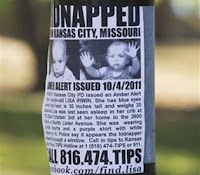Baby Lisa is still missing, so a high profile Private Investigator has been hired on her behalf. Will his presence help, hinder or make no discernable difference in the investigation into Baby Lisa’s disappearance? Obviously, this question is not easily answered.
I hired a Private Investigator when my daughter was kidnapped. Hap Lipset came highly recommended and was an internationally known Private Investigator whose specialty was electronic surveillance. After initially offering to share Polly’s case information, the Petaluma Police and FBI reneged and left my investigator to his own devices. By the end of the investigation three-months later, the best information that Mr. Lipset was able to provide to me was that a local newspaper was preparing to do a hit-piece on me. I was able to correct the record with the newspaper before the article was published and forestall an erroneous, but possible uncomfortable episode.
Private Investigators can definitely contribute to and enhance a missing person investigation. They provide an extra set of eyes and ears. However, while Private Investigators may investigate criminal matters, they do not have police powers. They cannot arrest or detain suspects.
Unlike sworn police officers, Private Investigators are not bound by the Miranda warning. In other words, they do not have to advise criminal suspects that self incriminating statements may be used against them. They may bring years of experience and local knowledge to the investigation.
If your child is missing and you wish to retain the services of a Private Investigator, there are certain things that you should consider. Particularly given that the law enforcement agency in charge of the investigation will most likely refuse to share evidence or other case information. The background, experience, and area of expertise of the Private Investigator you are considering must be synchronized with the goal you are trying to achieve: the recovery of the missing child.
Private Investigator’s come in various shapes, sizes, backgrounds, levels of experience and expertise. In a missing child case you want a Private Investigator that has a law enforcement background and contacts within the jurisdictional agency. You want an investigator with personal knowledge of the community and you want an investigator with a background in missing persons. In an ideal world you want someone who has actually found missing persons. Therefore, you want a local man or woman that has hopefully retired from law enforcement and has adequate resources to end run official stonewalling to either obtain or verify case information.
In one case that the KlaasKids Foundation was involved in the family of the missing person was interested in hiring a Private Investigator. I recommended an individual whom I had known since 1993 when he worked Polly’s case as a special agent for the FBI. He was able to verify that the FBI was involved in the case and that the local authorities were conducting a viable and thorough investigation. He recommended that he continue monitoring the investigation and provide the family with regular reports. Although the family appreciated the information, they decided to go with a pro-bono grandstanding Private Investigator who was unable to keep any of his promises and had virtually no impact on either the family or the investigation.
The Private Investigator that has been hired to work Baby Lisa’s case is named Bill Stanton. Mr. Stanton is from New York and seems to specialize in executive protection, not missing persons: Strike One!. This morning Kansas City Police Capt. Steve Young said that Private Investigators have no more access to crime scene evidence than the general public: Strike Two! Mr. Stanton has told at least one media representative that he is not in Kansas City in his capacity as a Private Investigator, but rather as a consultant or a new set of eyes. Therefore, his mission is not clear: Strike Three!
The decision on whether or not to hire a Private Investigator comes down to a matter of value, time and resource. What value can the Private Investigator provide that will assist in recovering the missing person? In this case it looks like that Mr. Stanton is a stranger in a strange land who must begin at square one. That in itself is a liability. Time is critical in recovery. More than a week has already passed and we seem no closer to finding Baby Lisa than the day that she disappeared. What resources does the Private Investigator bring to the case? In this case a reputation for bravado, and an opportunity to fuel the media cycle for a day or two.
Baby Lisa is still missing and the longer this goes on the grimmer the prognosis.
 Missouri Governor Jay Nixon has called upon members of the 1139th Military Police Company of the Missouri National Guard to assist in the search for Lisa Irwin, who has been missing from her Kansas City home since October 4. Twenty-five members of the unit have joined police in ground searches for 10-month-old baby Lisa. This is a very good sign as the military can contribute many disciplines and resources to a Search and Rescue operation.
Missouri Governor Jay Nixon has called upon members of the 1139th Military Police Company of the Missouri National Guard to assist in the search for Lisa Irwin, who has been missing from her Kansas City home since October 4. Twenty-five members of the unit have joined police in ground searches for 10-month-old baby Lisa. This is a very good sign as the military can contribute many disciplines and resources to a Search and Rescue operation.











